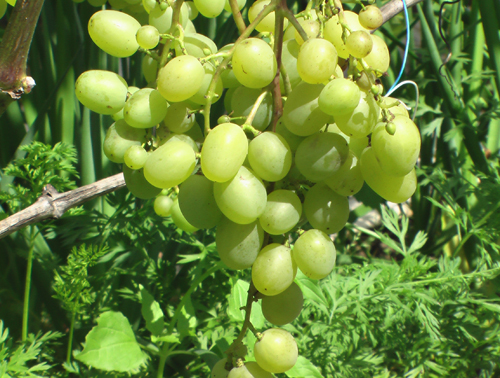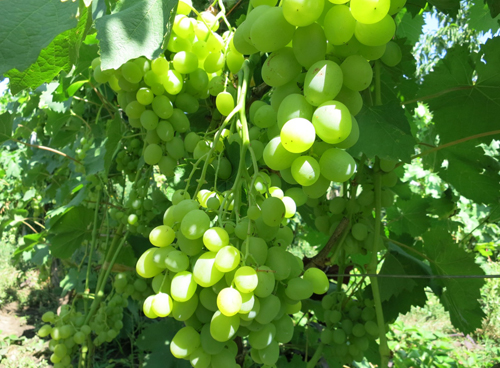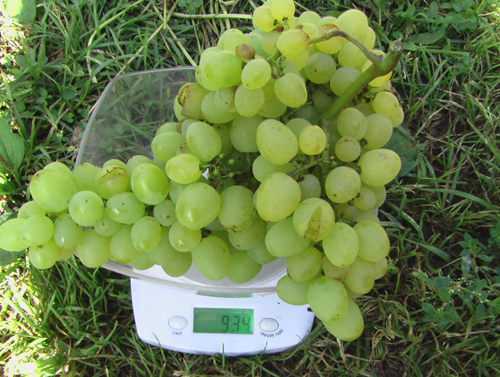Grape variety Super extra
Super extra table grapes are one of the first successful developments of the talented winegrower from Novoshakhtinsk, Rostov region of the Russian Federation, Evgeny Pavlovsky. Until a certain stage of his life, Yevgeny Georgievich, although he loved to deal with the vineyard in his free time from the main, miner's, craft, but in his thoughts he could not imagine that the day would come when he would seriously engage in the creation of new grape varieties, and some of them even fall into State register of breeding achievements of the country. Everything changed after meeting with the scientist VNIIViV them. ME AND. Potapenko by Ivan Kostrikin, who managed to captivate both Pavlovsky and several other winegrowers with the idea of so-called folk selection. He invited them to do crossbreeding activities, taking as a basis the maternal forms with a functionally female type of flowering, which greatly facilitated the whole process, and made it accessible even to beginners. Among these forms, a special place was taken by the famous variety Mascot, the author of which was at one time Kostrikin himself. With the help of the Talisman, which invariably passes on to its descendants genes for large-fruited and relative disease resistance, amateur breeders received a significant share of their novelties. The differences were only in the selection of paternal forms, the variations of which had been sorted out over the past years, a great many. Often, even from the same pair of parents, pollinated at different times and by different growers, new hybrids were obtained that were completely different from each other. The vast list of achievements in amateur breeding is literally replete with new diverse forms, in whose parents the same varieties are listed.

So Super Extra was born from crossing the Talisman with the Cardinal in a mixture with the pollen of other species. The pair can probably be called classic, since only Pavlovsky himself can count several hybrid forms with the same parents. However, this fact in no way diminishes the merits of the hero of our article, who immediately after its appearance became quite popular among winegrowers for a very early ripening period, the pleasant appearance of the bunches and a certain unpretentiousness in cultivation.
Subsequently, for transfer to the state variety test, the grapes, with the light hand of the author, changed their name to Citrine, with which in 2015 it was entered into the State Register of Breeding Achievements of the Russian Federation, approved for use in garden plots. However, among amateur winegrowers, the new name did not take root, and the variety is known to most of them by its original name - Super Extra.
Agrobiological characteristics
The bushes of the hybrid are powerful, fast-growing, early bearing. The leaf is medium-sized, rounded, slightly dissected, five-, less often three-lobed, dark green. The surface of the leaf blade is smooth or reticulate-wrinkled, the reverse side is covered with light cobweb pubescence. The lateral notches are small V-shaped or absent at all, the petiole notch is open, lyre-shaped with a narrow aperture and a pointed bottom, or a closed narrow elliptical. The denticles along the edge of the leaf are large, triangular with a wide base and sharp tops. The flowers are bisexual, however, the variety has a tendency to pea berries, which, however, can be prevented by a number of simple manipulations.

The size and weight of grape bunches are traditionally large, the average weight ranges from 500-700 grams, the maximum is up to one and a half kilograms. The shape of the Super Extra brushes can be varied - conical, cylindro-conical, wide-conical and even winged, the density also varies from moderately knocked down to completely loose and depends on the quality of pollination. The crest is very long, branched, light green in color, at the base it can acquire a reddish-pink tint.The berries are large, slightly elongated, depending on the illumination of the sun when ripe, they can be greenish, white or amber, with an average size of 28 × 24 mm and weighing about 7-8 grams. A specific feature of the variety is a significant variety of grapes in a bunch, which somewhat spoils the presentation, but absolutely does not affect the taste. The pulp is juicy, fleshy, sufficient density is preserved even in overripe berries. The taste is simple, without unnecessary frills, but quite harmonious - one might say, standard for table grapes. The skin is quite dense and durable, while being eaten. The bones are present, but they almost do not spoil the tasting assessment. By the way, it is quite high and amounts to 8.4 points according to the results of the state test. The wasps, thanks to the strong skin, do not damage the berries, but they can crack in case of rainy weather when ripe or sudden changes in soil moisture. In this regard, the long presence of ripe bunches on the bushes after the onset of removable maturity is associated with significant risks.
The crop is used for fresh consumption. Due to the impressive size of the bunches and the pleasant color of the berries, the grapes can be called “marketable”, especially if measures are taken to prevent the peeling of the berries, which may affect the general presentation of the harvested crop. Suitability for storage and long-distance transportation of Super Extra bunches at height. The dense skin prevents mechanical damage to the berries, which determines good keeping quality and transportability.

The ripening time of the crop is very early. The growing season is only 90-100 days, thanks to which you can start harvesting in the south at the end of July. The same circumstance makes the variety very popular in northern viticulture, because, given the small amount of active temperatures required for ripening (2050-2150 ° C), it can ripen without any problems even north of the Moscow region. Many amateurs have turned their eyes to this hybrid due to this very circumstance. Although its frost resistance is average (-22 ... -23 ° C), in frost-prone regions this problem is solved by carefully covering the vines for the winter.
The yield of Super Extras will delight the most discerning growers in this regard. In a mass planting during the state variety test, he showed the result of 169 c / ha, and single bushes from many amateurs give 20 kilograms of excellent bunches each without signs of overloading the bush. By the way, the variety is rather prone to it, so it is necessary to objectively assess the strength of each plant, regulating the load on it, and not chase the quantity at any cost. If this is not done, then there is a great chance to get a lot of low-quality watery and tasteless grapes, and even harm the bush itself, which will not have the strength to prepare for winter. It is also worth mentioning the possibility of obtaining a second harvest in the south on stepchildren, which in the size of bunches will be much lagging behind the main one, but, due to better summer pollination, will differ in better uniformity of berries.
Indicators of sugar accumulation in Super Extras are standard for a table variety - 16-19 grams per 100 ml of juice. Acidity - 5-6 grams / liter.
Agrotechnical features
The process of cultivation of this variety of grapes is not associated with excessive difficulties, but at the same time, one cannot fail to note some nuances, ignoring which can negatively affect the yield indicators, the quality of the bunches and even the viability of the grape bushes themselves.
First of all, you need to decide on the choice of planting material. The fact is that Super Extra grows equally well both in a rooted culture and in a grafted one.However, due to insufficient resistance of the variety to phylloxera, rooted cuttings are permissible for planting only in areas free from this soil pest. Where phylloxera has already firmly established itself, the establishment of new plantings is possible only with seedlings grafted onto stable rootstocks.
The formation of grape bushes depends on the region of cultivation and those temperature minimums that are typical for it in winter. If, according to long-term observations, they do not exceed the critical for the variety -23 ° C, then it is quite acceptable, and even preferable, to form vigorous plants on a high stem, giving them the opportunity to demonstrate all their potential capabilities. If there is a risk of damage to the vines by cold weather, then it is worth thinking about sheltering the vines for the winter and choosing appropriate bush management systems for this.
With regard to fungal diseases, Super Extra demonstrates ambiguous resistance: if its resistance to mildew is high, then it is damaged by mildew to a moderate degree, and it is completely susceptible to gray rot. The main harvest in the south is saved from gray rot by the early ripening period, because in the sultry summer, the conditions for the reproduction of the pathogen, frankly, are far from ideal. However, in unconventional northern wine-growing regions, with their humid and cool climate, the struggle for the harvest can be quite grueling. From oidium everywhere, several sprays will be enough during periods when the disease can be most harmful.
Fruiting plantings of the variety need measures to improve the pollination of inflorescences and to prevent overloading of grape bushes with crops. In terms of the implementation of the first task, good results are shown by the pinching of fruitful shoots before flowering, as well as good ventilation of the fruit zone in its process. Rationing of the same crop consists in a competent approach to spring pruning, and in additional regulation in the course of green operations. The recommended load on the Super Extra bush in spring is quite modest - 25-35 eyes, but it can deviate somewhat in one direction or another, depending on the vital energy of the plant, its age and the volume of accumulated perennial wood. The length of pruning of fruit arrows can be different, but, as a rule, a short (2-4 buds) or medium (5-8 eyes) is used. On a growing bush, weak and sterile shoots are traditionally broken off, and on the remaining ones, one, the strongest brush is left.
The fulfillment of this minimum of recommendations will be quite enough to obtain decent yields of Super Extra, however, as you know, there are no limits to perfection, and therefore it will never be superfluous to improve the agricultural background as a whole, to make regular watering and feeding with moderate doses of fertilizers. You can be sure that this work will not be wasted, and the grapes will certainly thank you for their care with the generosity of the harvest.








